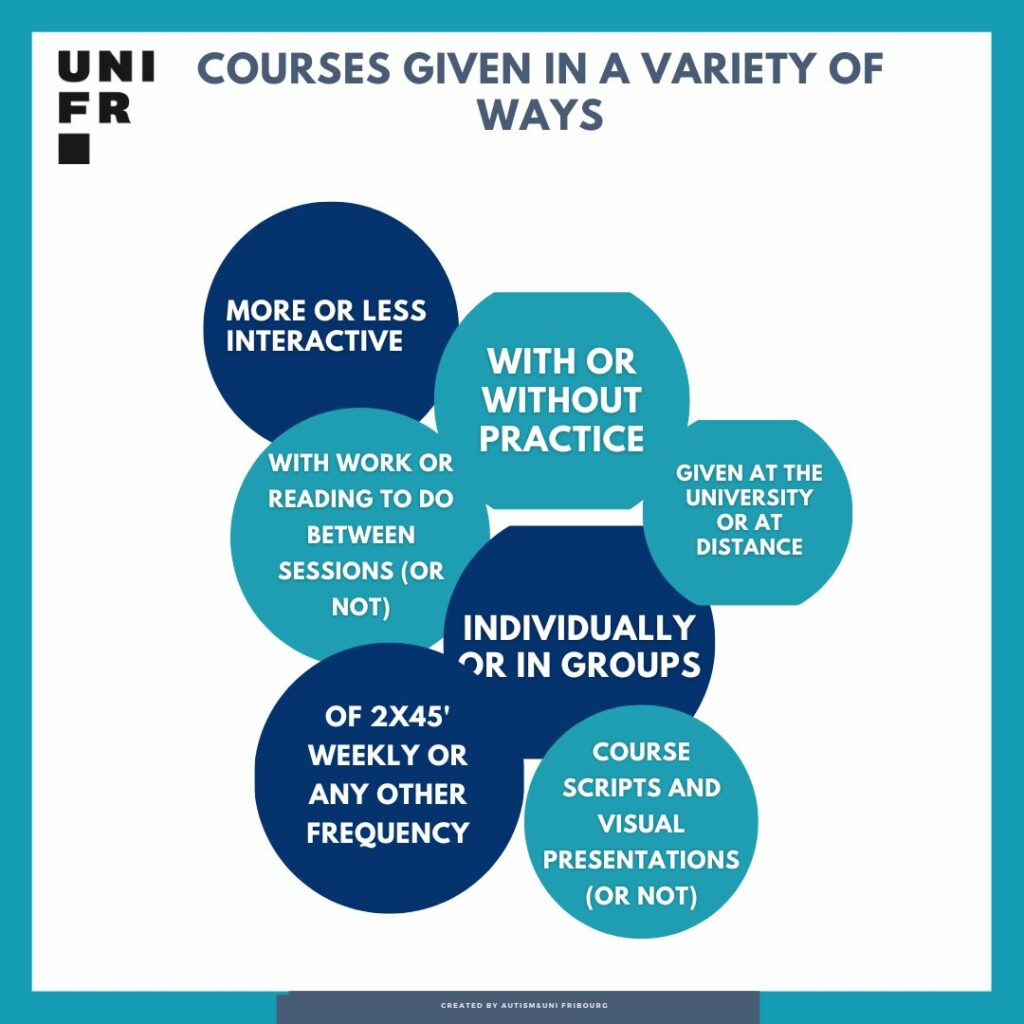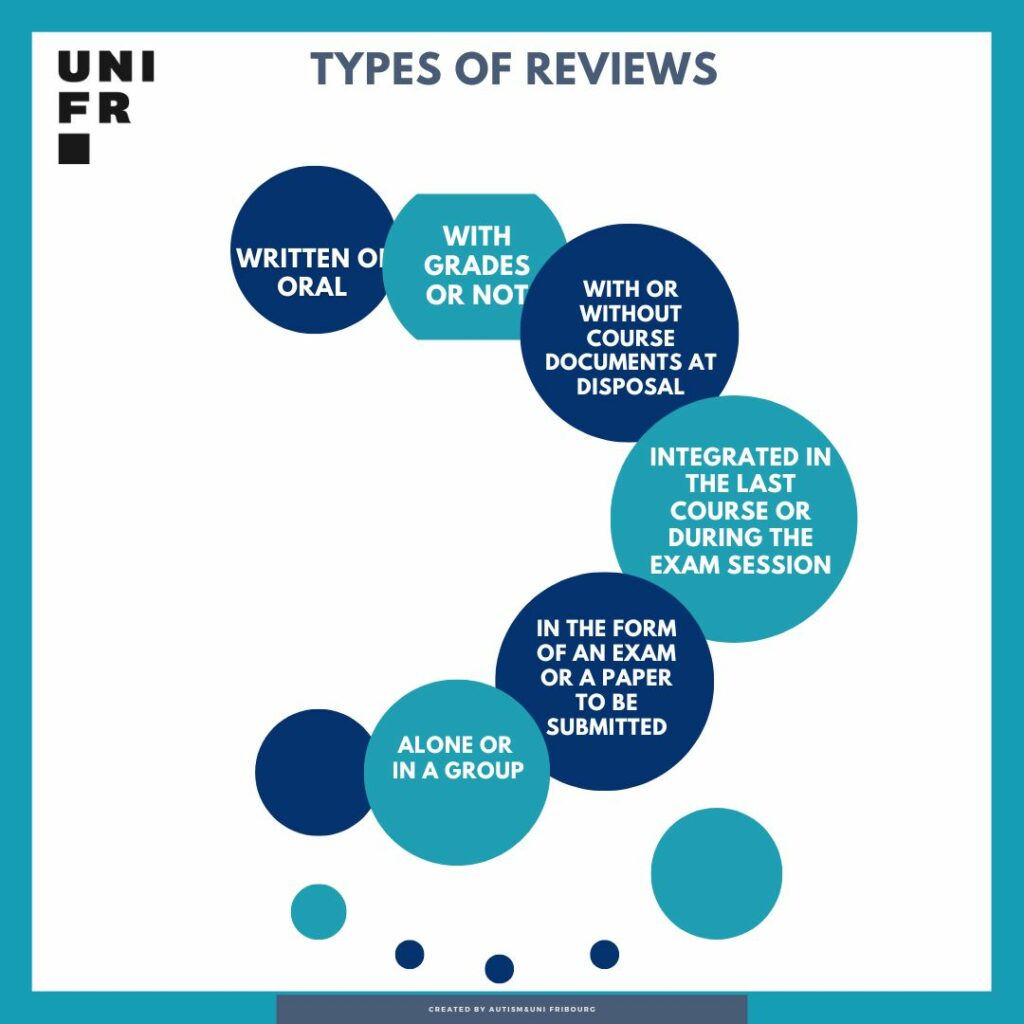There are different ways of teaching and examining at the University. In this section you will understand the different levels of involvement required of students for each type.
Context
The lecturers at the University of Fribourg are chosen among experts in their field. They are therefore often researchers or professionals with solid experience in the field.
Some teachers are professors at the University, while others have another function (e.g., lecturers, scientific collaborators, teaching and research staff members, graduate assistants, external lecturers). For example, a psychiatrist or a judge could be hired to teach two hours a week at University and work the rest of the time independantly. Some teachers are trained in university didactics or adult education, but not all. Teachers are therefore hired on the basis of their expertise in a subject area and not on their teaching skills per se. Thus, each teacher is free to organize his or her courses according to his or her preferences.
Teaching at the University is based on a system that places priority on excellence in knowledge. Because of the diversity of the teaching staff, courses are taught in a wide variety of ways. This diversity is rich and exciting. The system thus works on the assumption that students adapt best to all these teaching models. With some adjustments on both sides, this system works quite well.
It is difficult to know what a course is until you attend it. Courses can take different forms, with different degrees of student involvement, which we will detail here:
Face-to-face, distance or hybrid teaching:
In face-to-face teaching, lectures are often given in an “ex cathedra” format: the teacher stands in front of the audience’s screen, showing a PowerPoint presentation to explain his or her ideas. Little student involvement is required. During this time, students can take notes by hand or on the computer if they wish. They are allowed to raise their hands to ask questions. Some courses are more interactive. The teachers give some explanations and then ask the students to get into groups to do an exercise for example. In this category, there are lectures, but also practical sessions and seminars on individual work that is discussed in groups. In the Socializing and Studying section, you will discover strategies for managing these social moments.
With the 2020 pandemic, many courses have been taught entirely by distance learning. Again, there is great variation among teachers: some speak and share their PowerPoint presentation on the computer screen as if the students were in the audience, while others provide far more interactive subgroup work. Many teachers choose to work with Teams, but some prefer Zoom or Skype. This requires some flexibility on the part of the students, especially in the beginning.
Finally, some courses are given in a hybrid way: some courses of the semester will be given in presence and others at a distance.
In addition, your study program may include internships, excursions, and off-campus stays.
Most of the weekly classes are twice 45 minutes long. In principle, the teacher agrees on the appropriate rhythm with the students. The most common pattern is 45 minutes of class > 15 minutes of break > 45 minutes of class. But some teachers prefer to have 90 minutes of consecutive lessons and to finish 15 minutes earlier. So, there is always at least a 15-minute break before the next class.
Whether the course is online or face-to-face, it is important to arrive on time so as not to disturb the teacher. For the same reasons, students do not normally move around freely during class and only get up at break time or at the end of class.
In the majority of cases, no attendance checks are carried out.
Pace and format of the courses :
Most courses are given on a weekly basis, two hours per week. But some courses are given in compact blocks, for example, as a few whole days of the same subject. Some courses are given in a classical way (the professor speaks, the students listen and take notes), others are more participative (students are encouraged to collaborate with each other, to produce presentations, to think in a collaborative way), and others are given in a seminar form (participative course around a personal project).
Course materials
Many students ask to be able to read the course material in advance. When this is explicitly requested, most teachers agree to make it available. However, many lecturers adjust their content until the last moment and do not make their presentations available in advance. As long as the request is made in a constructive way, a discussion about it with the teacher is always possible.
At the University of Fribourg, most teachers make their presentations and all necessary documents available on the Moodle platform. Moodle is a teaching support platform.
Some teachers still prefer to work on their own, offering readings from book chapters, scientific articles, or exercises to do between class sessions. Usually, the teacher will clearly explain his or her expectations for the course, for the exam, and will tell you where to find the information.
Written and oral examinations
Reviews can take many forms:
- written or oral
- with or without notes
- with or without the course material available
- integrated into the course (often in the last class, or with an assignment) or during the exam session
- alone or in a group
- to be carried out over the course of an hour or two
Each teacher makes the decisions that he or she feels are most appropriate to best assess the content of the course. For example, a written examination may take the form of a multiple-choice questionnaire, open-ended questions, closed-ended questions, case analyses or exercises. An oral exam can be prepared according to a list of questions given in advance, or it can be a spontaneous discussion according to the teacher’s indications.
In principle, the teachers clearly explain the instructions for the exam at the beginning of the semester and communicate the validation grid for the exam.
What does that have to do with me?
As a student, you have to understand the content being taught, take notes, be in a large group, deal with sensory stimuli and socialize. This is both challenging and exciting. Many students enjoy the courses because they give them the opportunity to learn more about a subject they are passionate about from an expert. The chapter on learning strategies gives tips on how to be effective in note taking and how to best prepare for exams.
Once you have chosen your course of study, you will study a number of modules each year. These modules are a breakdown of your general curriculum into sub-topics. You will be able to choose some of them while others will be compulsory. As you complete your modules, you’ll earn credits that will allow you to progress through your course.
The programmes are designed to give you a comprehensive education so that each module contributes to your progress. Most students enjoy and do better in one area than another.
What is the next step?
Organize your schedule according to the courses in your study programme
Practical advice
- Find an effective way to take notes. The chapter on learning strategies will give you some tips
- If possible, arrive at class a few minutes early so that you have enough time to settle in
- If necessary, go to the bathroom before class so you don’t have to get up during class
- Sitting at the front of the audience makes it less likely that you will be distracted by the watching the other students
- Sometimes arriving late is unavoidable. Just come in and try to make as little noise as possible and sit in the first available seat (even if it is not your usual seat). This also applies if you have to leave the class before the end
- Other students may arrive late or leave class early. This can be a distraction.
- If you arrive too early for a class, the previous class may leave when you arrive and you may be caught in the crowd of people leaving
- Spend some time next to the auditoriums you are interested in around usual class times to understand the usual entry and exit times, or look at the occupancy map hanging next to each room
- Most teachers allow students the freedom to raise their hands at any time to ask questions. If the teacher prefers to save the questions for the end of the class, you can write them down so that you have them in mind for question time.
- If you have several questions about the course topic, the research you have done or if you want to get information for your personal homework, it is advisable to ask the teacher these questions after the course:
- Either at the end of the lesson, if the teacher takes time to do this
- Or by sending an e-mail to the teacher to ask the questions
- Or by making an appointment by email or in person, to ask the questions
- At the beginning of each semester, check that you are registered for the course (teaching unit) and the exam.
“During my first year, I missed a lot of classes and often had to leave the classroom during a lecture because I had severe anxiety from being surrounded by students sitting around me. Not being able to move freely and being in a windowless room with neon lights was complicated. The teachers knew this could happen, so they didn’t mind, and they knew I wasn’t being rude.” (Fern, final year student, Autism&Uni Interview)
Questions to ask yourself
- Have you noted all the courses that make up your year at the University?
- Did you choose to do them all?
- Have you noted the course dates in your diary?
- Have you visited the buildings to find out about the room?
- Did you understand what was expected for the exam?
- Have you organized your individual work in preparation for the exam?
- Have you checked your course and exam registrations on Myunifr?
Additional information
- Academic Advisor (Student Advice and Information)
- Timetable
- Myunifr
- Studies and Disability Office
- Structure of studies at the University of Fribourg
- CONTACT
About the author
Edited by: Nathalie Quartenoud ©
Translated by: Daniel Dukes


 Back
Back 
